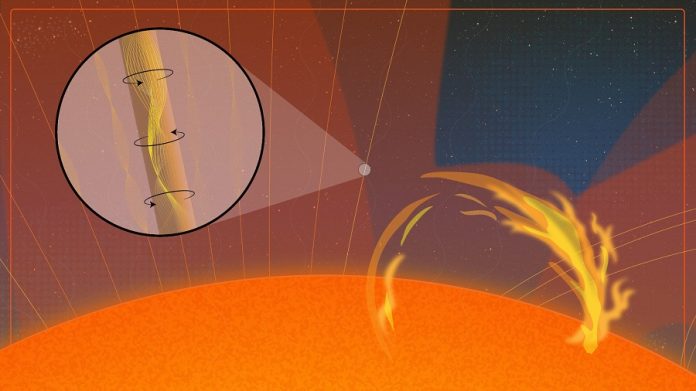
For more than 80 years, scientists have been searching for a special kind of magnetic wave inside the sun that could help explain one of astronomy’s biggest mysteries—why the sun’s outer atmosphere, called the corona, is millions of degrees hotter than its surface.
Now, for the first time, researchers have found direct evidence of these elusive “twisting” magnetic waves, known as torsional Alfvén waves, inside the corona.
The discovery, published in Nature Astronomy, was made using the world’s most advanced solar telescope—the Daniel K. Inouye Solar Telescope in Hawaii.
This telescope, operated by the U.S. National Science Foundation, is four meters wide, making it the largest solar telescope ever built.
Its powerful instruments can observe incredibly fine details in the sun’s atmosphere that were invisible before.
Alfvén waves were first predicted in 1942 by Swedish scientist and Nobel Prize winner Hannes Alfvén.
These waves travel through plasma—the hot, charged gas that makes up most of the sun—by twisting magnetic field lines back and forth.
While scientists have seen larger versions of these waves connected to solar flares, the smaller, constantly occurring ones had never been observed directly until now.
The breakthrough was led by Professor Richard Morton from Northumbria University in the UK, who called the discovery “the end of a long search that began in the 1940s.”
He and his team used a special instrument called the Cryogenic Near Infrared Spectropolarimeter (Cryo-NIRSP), which measures light from hot gases in the sun’s corona.
This device allowed the team to study the motion of plasma heated to 1.6 million degrees Celsius—roughly 300 times hotter than the surface of the sun.
The challenge, Professor Morton explained, was that the corona is filled with different types of motions that overlap and make it hard to tell them apart. “The movement of plasma is mostly dominated by swaying motions,” he said.
“These hide the twisting motions, so I had to develop a way to remove the swaying to find the twisting.” His new analysis technique revealed the hidden signature of torsional waves—tiny twists that move magnetic energy through the corona.
Unlike the more familiar “kink” waves, which make entire magnetic structures move side to side, torsional Alfvén waves twist along the length of the magnetic field lines. These twisting motions can’t be seen directly in images, but can be detected by looking at how light shifts as plasma moves toward or away from Earth—producing red and blue shifts on opposite sides of the magnetic loops.
This discovery is more than a scientific curiosity—it may finally explain how the corona becomes so incredibly hot.
The waves could transfer and dissipate magnetic energy throughout the corona, heating the plasma and helping drive the solar wind, the constant stream of charged particles that flows from the sun and fills our solar system.
The study also helps scientists better understand space weather, which can affect satellites, GPS systems, and power grids on Earth.
The energy carried by Alfvén waves could be linked to the “magnetic switchbacks” detected by NASA’s Parker Solar Probe—sudden reversals in the solar wind’s magnetic field.
Professor Morton’s discovery, made in collaboration with scientists from China, Belgium, the U.S., and the UK, marks a major milestone in solar physics. With the Daniel K. Inouye Solar Telescope now fully operational, researchers expect many more discoveries about the hidden forces that power our nearest star.



